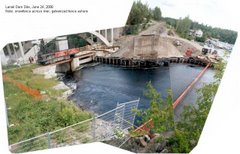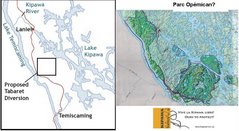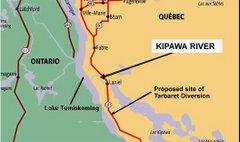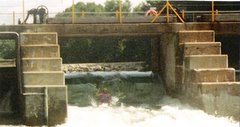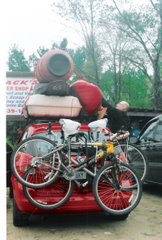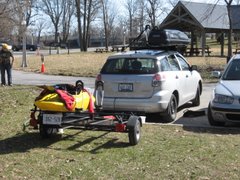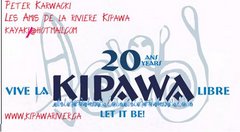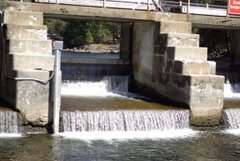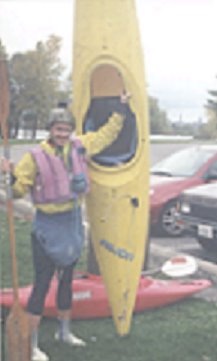
The Kipawa Legal Challenge is a request for a Judicial Review of the Environmental Screening Process conducted by PWGSC for the Refurbishment of the Laniel Dam. What exactly is that Process?
SCOPE OF THE Environmental ASSESSMENT
FEDERAL PROJECT CATEGORIZATION
The Canadian Environmental Assessment Agency (“CEA Agency”) determines if the Canadian
Environmental Assessment Act (“CEAA”) applies to a project, and follows a four-step review process for
environmental studies conducted under its jurisdiction:
Step 1: Does CEAA Apply?
The CEAA requires federal authorities to undertake environmental assessments of projects when they are
proponents or when they are proposing to take one of the following actions that would enable a project to
proceed, in whole or in part, by:
• providing some form of financial assistance to the project
• having the administration of federal lands and selling, leasing, or otherwise disposing of those
lands or any interest in those lands
• issuing a permit, licence, authorization, or other regulatory approval listed in the Law List
Regulations.
Since an application has been made to NRCan for WPPI funding, the proposed Project is subject to the
conditions and requirements of CEAA. Once the applicability of the CEAA has been determined, the next
step is to identify the type of study required.
Step 2: Identification of Study Type
There are two general types of studies identified under CEAA: Self-Directed and Public Review.
The majority of federal projects are assessed through a screening; however, some projects require a
comprehensive study. These projects are described in the Comprehensive Study List Regulation and
tend to be large projects having the potential for significant adverse environmental effects. They may also
generate public concerns. Screening studies are typically undertaken for small-scale projects with minor,
predictable, and mitigable environmental effects, whereas comprehensive studies deal with projects that
have the potential to result in significant environmental effects.
Approximately 95% of the environmental studies conducted under CEAA are screenings. ESP (Environmental Screening Process)
Section 18 (1) of CEAA states that where a project is not described in the Exclusion List Regulation or the
Comprehensive Study List Regulation, the Responsible Authority (“RA”) shall ensure that a screening of
the project is conducted. The proposed Project is not described in either the Exclusion List or
Comprehensive Study List Regulations. Thus, the Project has been assessed as screening study and this
ESR/EIS prepared.
A screening study is a self-directed assessment in which the RA, in conjunction with other Federal
Authorities (“FA”), determines the scope of the study, manages the EA process, and ensures the
proponent prepares an appropriate screening study. For the proposed Project it is possible that the
following agencies will be RAs and thus responsibility may fall to them to ensure that the screening report
is carried out in compliance with the CEAA:
• Natural Resources Canada (“NRCan”)
• Fisheries and Oceans Canada (“DFO”)
• Correctional Services Canada
• Transport Canada.
Where more than one RA is involved with a project the RAs may decide if a lead RA should be designated
to coordinate tasks in conducting the EA. If a lead RA is not designated the EA can be managed as a
committee. It is important to note that lead RA is an administrative function; the designation of a lead RA
does not change the legal responsibilities of the various federal authorities under CEAA. The FAs for this
Project may include:
• Environment Canada/Canadian Wildlife Service
• Health Canada
• Transport Canada.
Step 3: RA Determination
The RA’s determination is not whether to proceed with the project, but rather concerns the likelihood of
significant adverse environmental effects. The three determination options available to the RA are:
1. the project is not likely to cause significant adverse environmental effects – following this
determination the RA may exercise any power or perform any duty or function that would permit
the project to be carried out in whole or in part
2. the project is likely to cause significant adverse environmental effects that cannot be justified –
following this determination the RA may not exercise any power or perform any duty or function
that would permit the project to be carried out in whole or in part, or
3. it is uncertain whether the project is likely to cause significant adverse environmental effects, or
the project is likely to cause significant adverse environmental effects that may be justifiable, or
public concerns warrant referral to a mediator or review panel – following any of these
determinations the RA must refer the project to the federal Minister of the Environment for a
referral to a mediator or review panel.
Step 4: Review and Determination
The decision options for an RA following a review panel or mediation are as follows, the project is:
• not likely to cause significant adverse environmental effects or the project is likely to cause
significant adverse environmental effects that can be justified in the circumstances – following this
determination the RA may exercise any power or perform any duty or function that would permit
the project to be carried out in whole or in part, or
• likely to cause significant adverse environmental effects that cannot be justified – following this
determination the RA may not exercise any power or perform a any duty or function that would
permit the project to be carried out in whole or in part.
PROVINCIAL PROJECT CATEGORIZATION
Regulation 116/01 sets out the ESP as a proponent driven, self-assessment process.
The proponent is responsible for
1. determining if the project falls within the ESP and
2. when to formally commence the process.
3. The proponent is also responsible for determining the time required to adequately conduct the
ESP and
4. when to publicly release project documentation and/or solicit comments from stakeholders.
Under Regulation 116/01 new projects are classified into one of three categories:
• Category A: projects that are expected to have minimal potential environmental effects and do not
require approval under the EAA
• Category B: projects that have potential environmental effects that can likely be mitigated, but
require approval under the ESP of the EAA
• Category C: projects that have known potentially significant environmental effects and require the
preparation of an “individual environmental assessment” under the EAA.
There are two possible stages of environmental study required under the ESP depending upon the
potential adverse environmental effects of a project and/or stakeholder issues: “screening” and
“environmental review”.
All projects subject to the ESP are required to go through the screening stage, which requires proponents to apply a series of screening criteria to identify the potential adverse environmental effects of the project.
The more detailed stage, an environmental review, is required if potential concerns raised during the screening stage dictate a need for additional, detailed studies.
Based upon the MOE’s categorization of electricity projects, wind turbines / plants greater than or equal to
2 MW are classified as Category B Projects and thus subject to approval under the ESP of the EAA. This
categorization, coupled with the results of the screening criteria checklist (section 6 and Appendix B),
has led the Project to be assessed as an environmental screening under Regulation 116/01.
STUDY OBJECTIVES
Working within the federal, provincial, and municipal approvals processes, and consistent with the
potential RA’s scope of study and the MOE’s environmental screening criteria checklist, the main
objectives of the ESR will be threefold:
1. to identify, define, and assess the potential effects of the Project on Valued Ecosystem
Components (“VECs”). The VECs identified for study represent environmental features that are
known to occur or have a reasonable probability of occurrence within the study area and which
subsequently could be affected by the Project (e.g., wetlands, avian species, terrestrial flora, etc.).
2. to ensure environmental considerations are explicitly addressed and incorporated into the
planning, design, and decision-making processes
3. considering objectives one and two, to design a project follow-up and monitoring program that
contains plans to prevent, mitigate, and compensate for the potentially adverse environmental
effects of the Project.
STUDY APPROACH
Environmental Assessment is commonly defined as the process of identifying, predicting, evaluating, and
mitigating the environmental effects of a proposed project prior to making irreversible project decisions
and commitments (IAIA, 1999).
In carrying out the ESR the assessment will rely upon a number of
common data collection techniques (e.g., primary and secondary data) and predictive tools (e.g.,
dispersion modelling), all of which considered the following factors:
• Purposive: activities should lead to informed decision-making.
• Rigorous: assessment should apply best practicable science, employing techniques
appropriate to address the issues under investigation.
• Focused: concentrating on key issues and significant environmental effects.
• Practical: process should result in information and outputs that assist with decision-making in
a manner that minimizes time and finance requirements for the proponent.
• Transparent: the process should be easily understood and replicable by project
stakeholders.
How does one get to the Kipawa Campground
From Pembroke:
Hwy 17 west to Mattawa
Turn right to Juntion hwy #63 then right to Temiskaming this shortcut saves driving to North Bay.
Once you cross the bridges follow Hwy #101 north for 40 min.
You will come to the small town of Laniel, this is the put in site.
Camping is available just across the bridge or follow the road North for +- 7km and turn left on the Grande Chutes Road 7km, this will bring you to the take out and Scott Sorenson's.
PS There is one gas station/depannuer(store) in Laniel, stop in and talk to the owners, they own the camping site and will know what is going on.
Our advantage is that we are focused on this one issue but it does encompass the essence of our sport.
The blog covers much of what you've asked about . For back postings you must click on the arrows.
The Kipawa Case: Laniel Dam Refurbishment: Judicial Review -So, we got run over like a speedbump and need to be an 800 lb gorilla to
set/reset the precedent.
YES
Aside from Les Amis are there other local/provincial organizations with
protection/access as their mandate?
SPORADIC CPAWS, SIERRA CLUB, SIERRA LEGAL DEFENSE, FONDATION RIVIERES, ORCA, Canoe Ontario,RIVER KEEPERS, on and on
None truly dedicated
Are they connected?
NO
Talking with AW?
Not recently, problem: membership insurance: makes joint membership at present unaffordable
River access law in Canada:do we have less legal tools than the Americans particularly in Quebec along with the far lower population and density.
What law do we have to work with?
Canadian Environmental Assessment ACT
Canadian environmental Protection ACT
Navigable Waters Protection ACt
Ontario Environmental bill of Rights
In Ontairo MOE an MNR are at loggerheads: one protects the other exploits the environment.
How do you Ship Kayaks: BUS
playboat-shipping experience via Greyhound.
As long as your boat is 7ft long or less you'll be in fine shape. Wrapped/duct-taped some cardboard around it, more because there was some fine-print which said that they were not liable for damage to unpackaged items, so you want it classed as 'packaged' so that if anything did happen to it there would have some form of recourse. There may be limits to insurance, about $400 worth, for about $9. I Shipping from Ottawa to Calgary: all told, just about $40-$50 for shipping, insurance and COD charge if relevant. Time: about 5 days
Vancouver to Guelph in 4 days. just the boat itself, no wrap or bags or any of that stuff. worked perfectly.
Playboat from Ottawa to Canmore, 65$ wrapped in bubbles. Not one was popped! May take a while though, think it was about 5 days late
Peterborough to Lake Louise for $58.00. It arrived in 4 days and was in fine shape. Wrapped it in the manufacturers original shipping material that may be available at a local outfitter for free, 40 lbs. with wrapping
all star shipped from Moncton NB to Kingston, Ontario which took 22 hours.Starting with Acadian Bus Lines then got transferred in Montreal to Coach Canada. This was MUCH less costly than UPS or courier.






